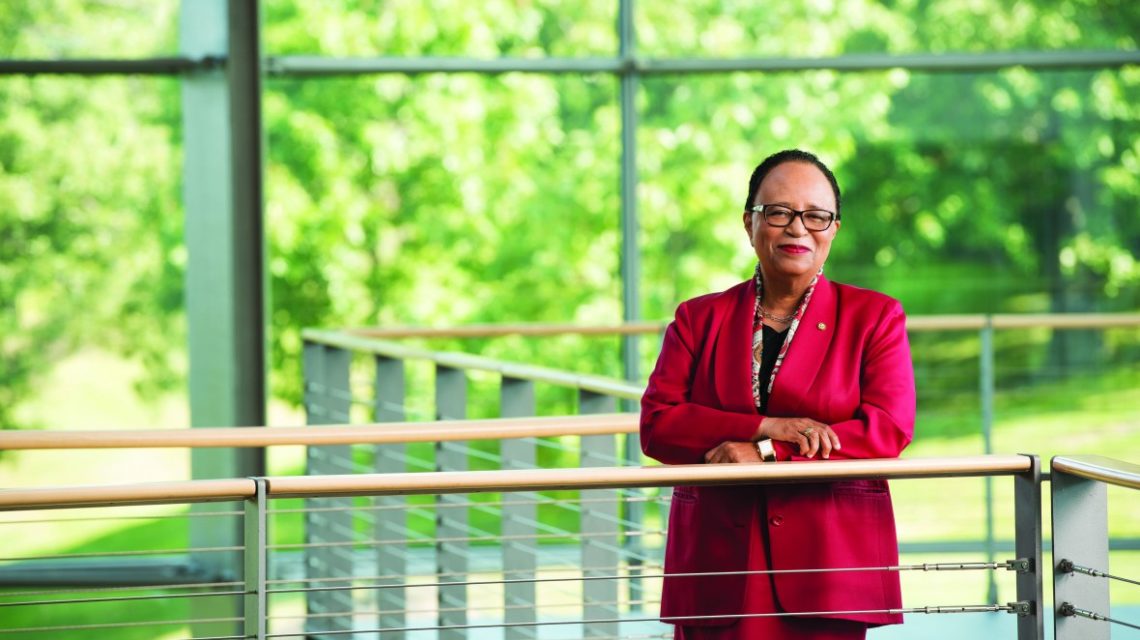By Amanda Schaffer
MIT Technology Review, December 19, 2017 —
Shirley Ann Jackson worked to help bring about more diversity at MIT, where she was the first African-American woman to earn a doctorate. She then applied her mix of vision and pragmatism in the lab, in Washington, and at the helm of a major research university.

Jackson with President Barack Obama in 2016 when he presented her with the National Medal of Science. DREW ANGERER | GETTY IMAGES
Shirley Ann Jackson arrived at MIT in the fall of 1964 as one of just a handful of black students and the valedictorian of her public high school in Washington, D.C. In the midst of working on her first physics problem set, she emerged from her room and noticed all the other first-year women on her floor out in a common area, doing theirs together. “If you know anything about MIT, you know that working the problem sets is a big deal,” she says. “So I gathered up my paperwork and said, ‘May I join you?’
“One of them looked up and said, ‘Go away.’
“I said, ‘I’ve done half the problems already and I know how to do the other ones.’
“And another girl said, ‘Didn’t you hear her? She said
go away.’”
And that was just the start. “It was pretty isolating,” Jackson says of her undergraduate years. Students avoided sitting next to her in lecture halls. If she joined others in the dining room, they would generally finish faster or skip their dessert. When that freshman study group rejected her, she went back to her room and cried. But after a while she told herself, “Well, I do have to hand in these physics problems.” So, she says, “I got myself together and finished the work.”
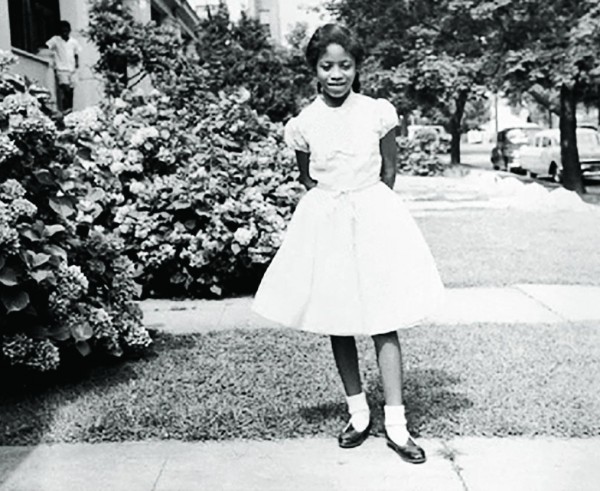
As a girl, Jackson studied the circadian rhythms of bees she captured from flowers and shrubs around her home. COURTESY OF SHIRLEY JACKSON
Jackson would need that kind of resilience to see her through nine years at MIT, as both an undergraduate and a graduate student in physics. Becoming the first African-American woman to receive a PhD from the Institute—in any field—served as prologue to a career that has spanned research, public policy, and academic leadership. She’s worked as a theoretical physicist at Bell Laboratories and chaired the U.S. Nuclear Regulatory Commission. She cochaired President Obama’s President’s Intelligence Advisory Board and served on the boards of IBM and FedEx. And since 1999, she’s been president of Rensselaer Polytechnic Institute in Troy, New York.
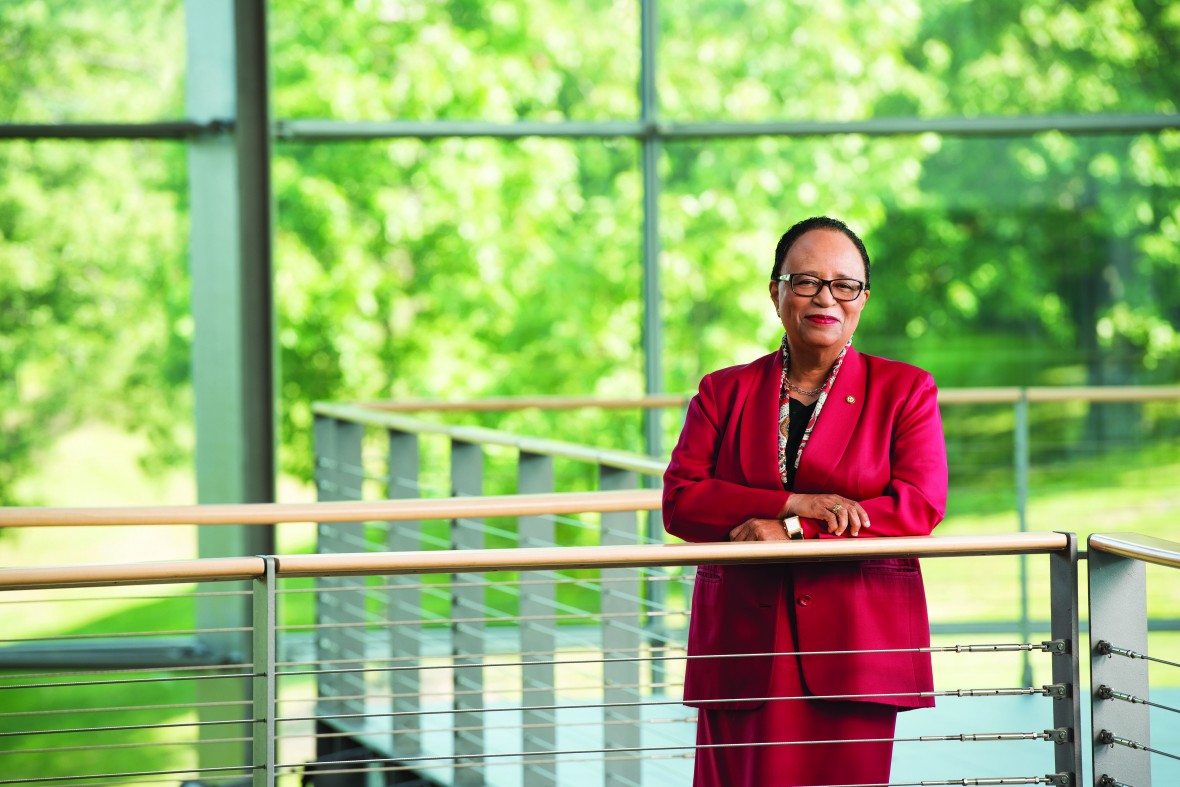
COURTESY OF SHIRLEY JACKSON
“It’s nearly impossible to understand the full sweep of Shirley’s career, from academia to government to business,” says Sylvester Gates, a physicist at Brown University who considered Jackson his mentor at MIT. “She has been extraordinarily successful in all of those realms. She also has a magnificent ability to understand organizations and how to be effective within them … She has always been the cool head in the group.”
Opening the aperture
Jackson stayed at MIT for doctoral work, partly because she recognized the power of an MIT doctorate, and partly because she “wasn’t going to give people the satisfaction of getting me to walk away.” Despite the bigotry she encountered, she remained a quiet student who focused on her work. The assassination of Martin Luther King in April 1968 changed that. Knowing MIT as well as she did, Jackson saw that she was in a position to “open the aperture” for more minorities and women at the Institute. She helped organize a group of African-American students that ultimately became the Black Student Union. The group drafted proposals (they thought better of calling them “demands”) to recruit more minority students, support them financially, improve their life at MIT, and hire more minority faculty members. Shortly thereafter, the MIT administration appointed a Task Force on Educational Opportunity and asked Jackson to serve on it. Led by Paul Gray, the associate provost and later MIT’s president president, the task force was charged with determining how to attract more minorities.
So during her first semester of graduate school, in the fall of 1968, Jackson traveled around the Midwest as part of a national effort do something MIT had never done before: recruit minority students. A year later, 57 African-American freshmen enrolled, up from three to five per year in previous years. To help those students succeed, Jackson helped create and then taught in a summer program called Project Interphase, designed to provide academic support for incoming minority freshmen and acclimate them to MIT. “I wasn’t the best student in her class,” says Gates, who had attended a segregated high school in Orlando, Florida, and was the first in his family to go to college. “But she was an amazing instructor and inspiration. She had standards of rigor and difficult physics problems the likes of which I had never seen.” In nearly five decades, more than 2,000 students have taken part in the program, now called Interphase EDGE.
When the Black Student Union emerged to give African-American students a sense of comfort and solidarity on campus, it was regarded by some as a “hotbed of radicals,” Gates says. “In fact it played the opposite role. Shirley was always saying, ‘The important thing is to concentrate on your academic performance and don’t get distracted.’” In 1970, when a group of minority students occupied the faculty club for an evening—in solidarity with minority workers on campus who were paid less than their white counterparts for the same work—some students worried that the Institute might retaliate. “There was concern that all the African-American students might be expelled,” Gates says. Jackson wasn’t involved in the occupation, but she was able to get the administration’s attention thanks to the relationships she had built through her involvement with the task force. “I worked hard to have everyone stay cool,” she recalls. Ultimately, she helped to ensure that there was no broad retribution. “I admired her greatly for being so effective in that role,” says Gates.
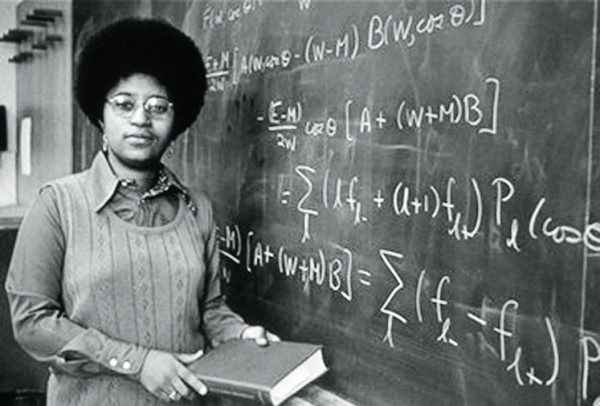
Jackson as an MIT student. MIT MUSEUM
A call from the White House
Jackson found strength in academic work and immersed herself in research, recording her equations in a large artist’s sketchbook that dwarfed the standard notebooks used by other theoretical physicists.
By 1973, she’d completed a doctoral degree in particle physics; her dissertation described a new way to model complex collisions. The next year, she began work as a postdoc at Fermilab, the national lab specializing in high-energy particle physics; she also did a fellowship at CERN. In 1976, she accepted a position at Bell Laboratories in New Jersey, where she switched research areas and focused on the electronic properties of two-dimensional condensed matter systems. “She’s very strong mathematically and made the transition successfully to a new field, which is not something too many people do,” says Patrick Lee ’66, PhD ’70, a colleague at Bell Labs and now a professor of physics at MIT. “It gives you an idea of her flexibility and breadth of interest.”
At Bell Labs, Jackson collaborated with Lee and others on research related to charge density waves, which describe how electrons organize themselves within layered crystals. The group was interested in how these electrons behave in areas where one layer of a crystal meets another. They focused in particular on how electrons cluster in repeated patterns, “with a particular kind of bunching effect,” as Lee puts it. They also modeled how these bunching patterns would change with variations in temperature—and how those changes would affect the properties of the material. “In those days, Bell Labs was very open to pure, basic research,” says Lee. Decades later, research on charge density waves has enjoyed a revival because of its importance in developing high-temperature superconductors, which have applications in everything from power transmission to quantum computing.
led to an ongoing position for Jackson at Bell Labs. Later, in 1991, she also joined the faculty at Rutgers University. During those years, she expanded into public policy work, advising Governor Tom Kean of New Jersey on how the state should invest in science and technology at its major research universities and serving on the board of the state’s largest utility.
In 1994, Jackson got a call from the White House: President Bill Clinton wanted her to serve as chair of the Nuclear Regulatory Commission. She accepted, even though it meant giving up her tenured position at Rutgers and spending the work week away from her husband, physicist Morris Washington, and their son, Alan, who was just starting high school. As head of the NRC, Jackson developed and implemented regulation for assessing risk at the country’s nuclear power plants. Her approach took advantage of sophisticated computer modeling—much of it pioneered at MIT—to make probability-based judgments about the likelihood of various problems. For instance, if a power plant operator wanted to make physical changes to the plant or operate it differently, regulators could more accurately predict the relative risks of those changes. Victor McCree, who joined Jackson’s staff at the commission in 1996 and is currently its executive director for operations, says the new approach was “probably the most significant philosophical and practical change in the history of the NRC.”
Jackson also led international efforts to promote nuclear safety, working in places including post-apartheid South Africa and the countries of the former Soviet Union. “My first year as chairman I went to Chernobyl, and that focuses the attention,” she says. Nearly a decade after the 1986 accident, the site still had high radiation levels emanating from the destroyed reactor, and radioactive contamination in a broad area around the plant. Jackson and her team “helped the Ukrainians figure out what to do and how to seal this thing up,” helping to train regulators and inspectors in the region. Jackson also spearheaded the creation of the International Nuclear Regulators Association, which supports nuclear regulation around the world.
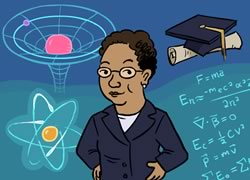
The cartoon is part of a National Academies of Science site aimed at getting girls interested in math and science. Shirley Jackson is listed as one of the site’s “10 cool scientists.” As the site’s cartoon host informed us: “Shirley can explore anything using just math and physics.” [image: The National Academies]
A Timeline of Shirley Jackson’s Career
- 1955 Begins collecting live bumblees and observing their reactions to changes in diet and light exposure.
- 1973 Earns her PhD in physics, making her the first African-American woman to receive a doctorate at MIT.
- 1976 Joins the theoretical-physics research department at Bell Labs after postdoctoral work at Fermilab and a stint at CERN.
- 1985 Begins advising New Jersey governor Tom Kean on how the state should invest in science and technology at its research universities.
- 1991 Joins the faculty of Rutgers University as a professor of theoretical physics.
- 1995 Appointed chair of the U.S. Nuclear Regulatory Commission by President Bill Clinton. She’s the first woman and first African-American to serve in that position.
- 1997 Helps establish the International Nuclear Regulators Association, serving as its first chair.
- 1999 Becomes 18th president of Reselaer Polytechnic Institute. She is the first woman and the first African-American to hold the position.
- 2001 Becomes the first African-American woman elected to the National Academy of Engineering
- 2004 Serves as president of the American Association for the Advancement of Science.
- 2009 Appointed by President Barack Obama to the President’s Council of Advisors on Science and Technology.
- 2016 Awarded National Medal of Science for work in condensed matter and particle physics, science-rooted public policy achievements, and inspiration to the next generation of STEM professionals.
Return to academia
Following her stint at the NRC, Jackson returned to academia in 1999 as president of Rensselaer Polytechnic Institute. As the sixth person to serve as president in 14 years, she aimed to transform RPI into a world-class technological research university. She was ready, having already served on the boards of Rutgers and MIT. (Jackson became a member of the MIT Corporation in 1975 and is now a lifetime member.) “I understood universities from the point of view of oversight and from the point of view of the faculty, in terms of how to organize research,” she says.
Jackson’s efforts to reshape the university met with resistance from some faculty. In 2006, she prevailed in a vote of no confidence by a small margin. (She says the faculty were concerned about tighter criteria and higher expectations for promotion and tenure, among other things.) In a separate struggle, her administration suspended the faculty senate in 2007. (The Board of Trustees had asked the senate to amend its constitution to limit its membership, resulting in an impasse; the senate was then reconstituted in 2012.) Jackson says that for legal reasons she can’t discuss the specifics, but that “change is hard—harder for some people than others.”
Change can also be expensive. In 2017, Standard & Poor’s lowered the university’s long-term bond rating from A- to BBB+, citing its high debt burden and low level of available resources. But RPI maintains an A3 bond rating with Moody’s, and Jackson plans to shore up the university’s finances with a capital campaign launched this past fall. The new campaign follows her successful Renaissance at Rensselaer campaign, which had raised over $1 billion by 2008 in support of her vision for RPI, known as the Rensselaer Plan. That funding helped the school reduce the student-faculty ratio from 18:1 to 13:1; dramatically increase research funding from $35 million to $100 million annually; and construct new facilities, including biotechnology and nanotech buildings and an experimental media and performing arts center.
And those investments appear to have paid off: since Jackson’s arrival at RPI, applications have nearly quadrupled, research dollars have tripled, and the student body is more diverse in terms of gender, ethnicity, and geographic background. Today, she says, the most pressing issue on her mind—and what she considers one of the major issues facing American higher education—is funding for basic research and support of graduate students, who she calls “the basis of our innovation ecosystem.”
Speaking out for science
Meanwhile, Jackson has also become a prominent voice on scientific and technical issues that matter to the country. From 2009 to 2014, she served on the President’s Council of Advisors on Science and Technology (PCAST) for President Obama; in 2014 she became cochair of the President’s Intelligence Advisory Board, serving until early 2017. In these positions, she led a study on advanced manufacturing in the United States and got involved with issues of national and global security, cybersecurity, and digital technology.
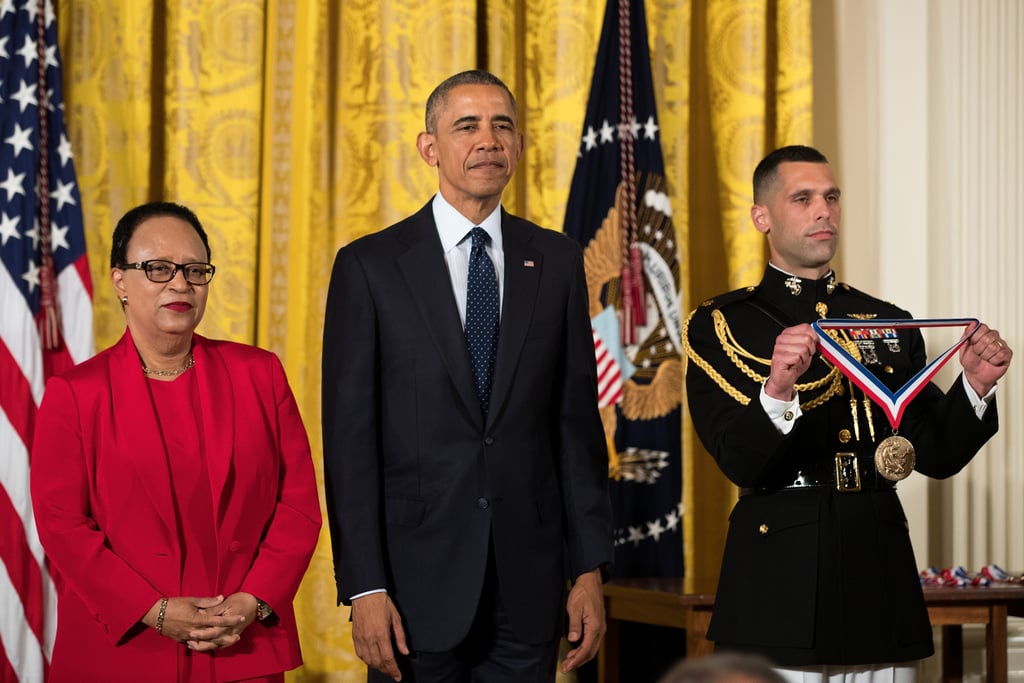
Jackson with President Barack Obama in 2016 when he presented her with the National Medal of Science. DREW ANGERER | GETTY IMAGES
“She has a broad view of how science and technology can assist our country and the world,” says Gates, who served with Jackson on PCAST. In 2016, Obama awarded her the National Medal of Science.
“It’s important to serve,” Jackson says. “It does take a lot of time. But I don’t play golf. And I have the ability to learn fast.”
Although she’s now a widely respected spokesperson for science, she tries to stay away from some topics, like whether evolutionary theory contradicts religious beliefs: in certain quarters, she says, that argument is “unwinnable.” Instead, she focuses on pragmatic responses to serious problems. For example, even for those who deny humans’ role in climate change, the increased frequency and severity of extreme weather events “stares you in the face,” she says. “You can see the effects in housing, in the stability of roads.” So she encourages people to help look for ways to address those effects “even if you don’t believe that at the front end is climate change.” (Of course, she also acknowledges that building practices only go so far, and scientists and public policy experts need to keep talking about the root causes of climate change.)
These days, flags from dozens of countries from which RPI students hail encircle the school’s dining hall: just under half the school’s graduate students, and about 11 percent of its undergraduates, come from abroad. In February, after President Trump announced his travel ban, a large group of students and faculty marched from the campus to downtown Troy in solidarity with international students, says Tobe Ezekwenna, a computer science graduate student from Maryland. Even though RPI is not generally known for political activism, he says, “people here really care about their peers.” And even in the Trump era, says Jackson, RPI is still in “high demand” among international students, although international applications for graduate programs in the United States have declined in the past year.
In light of this, Jackson argues that universities must redouble their efforts to attract and support students from abroad. The United States has always benefited from “great enterprises created by immigrants,” she says. International students broaden the perspective of their peers, who may go on to work in government, multinational corporations, or other organizations dealing with challenges like food, water, energy, and health that “cannot be solved on a local or national level,” Jackson adds. “People have to learn to work across geographies and cultures.”
It’s also imperative to increase the number of women and minorities pursuing careers in science, she says. During her presidency at RPI, the proportion of female undergraduates has gone from 24 percent in 1999 to 32 percent in 2017, and those numbers for graduate students have increased from 28 percent to 31, which she describes as positive but by no means sufficient. (By comparison, at MIT, 46 percent of undergraduates and 34 percent of graduate students are women.)
She has also tried to encourage underrepresented students earlier in their education. For the past 15 years, Jackson has worked closely with an independent school in New York City called Harlem Academy, which provides a rigorous education to low-income students from first to eighth grade. Each year, the academy’s older students spend three days at RPI, exploring science and university life. The school’s leader, Vinny Dotoli, says that Jackson is not only an inspiration to his students but also a dedicated mentor to him. “She always talks to me about pushing myself more and going out on a limb more,” he says, “but she’ll do it in a way that feels encouraging, where I walk away feeling excited to dive back into the work.”
So You Want to Change the World…
Shirley Ann Jackson’s advice to MIT students
-
- Never let academics falter; you have to be successful to have authority to champion change.
-
- Don’t be afraid to ask for help.
-
- Be straightforward.
-
- If you want to be respected, don’t disrespect others.
-
- Try to bring other people along.
-
- In spite of what most people think, revolutions don’t occur overnight. There may be a tipping point, but a whole lot of work precedes it.
- If you’re at a standstill, keep working. Important things tend to be hard. Stay focused on why you started down a particular path in the first place.
In a visit to MIT this fall, Jackson offered words of encouragement to students, including one who worried that maybe she was there because of affirmative action. “If you’re here, a door opened for you,” she told the student, noting that doors open for many reasons. “What happens now is a function of what you do.”
Amanda Schaffer

